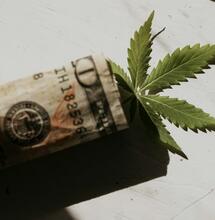How Coffee Grounds Can Improve Your Garden

Coffee grounds may be used as an inexpensive and natural supplement in your organic Cannabis, fruit or vegetable garden.
Coffee grounds may be used as an inexpensive and natural supplement in your organic Cannabis, fruit or vegetable garden.
Continuing our series on folk wisdom and gardener's tricks, what follows is a brief explanation of why and how coffee grounds are applied to gardens.
|
Spent coffee grounds can often be sourced from public coffee purveyors – usually for free. [Credit: Shanegenziuk/WikiMedia Commons] |
Why Coffee Grounds Are Used As a Garden Supplement:
Technically a 'seed meal', spent coffee grounds serve as an inexpensive or even free (certain coffee chains often have a bin from which gardeners take what they want) soil supplement that also provides extra advantages. Due to their high nitrogen content, used grounds may be applied either directly onto the soil surface, around the base of the plant or tilled into the soil to offer time-released benefits. Utilizing both the grounds and chaff from home-roasted beans, gardeners are able to lessen the amount of food waste that leaves their kitchens by applying them to flower beds, vegetable plots or Cannabis plants.
Ranging from mildly acidic to mildly alkaline, with a nitrogen content of around ten percent, the pH of these kitchen castoffs ranges from about 5.8 to 6.2 - falling within the desired range for soil cultivation. Natural supplements such as this not only help to save home growers a lot of money, but they also ease the burden on our landfills and garbage dumps. In addition, if non-bleached paper coffee filters are used, the entire lot may be considered for composting, for example, without placing additional strain upon the environment.
|
Results of a pH home test on spent coffee grounds; a further raising of pH levels would be expected if added to compost for use as a soil amendment. [Credit: Shanegenziuk/WikiMedia Commons] |
The Soil and Plant Laboratory Inc., in Bellevue, WA states that used coffee grounds contain 2.28 percent nitrogen, 0.06 percent phosphorus and 0.6 percent potassium - a healthy ratio for both the vegetative and flowering phases.
According to a Sunset.com report, total nutrient levels are as follows:
"Each cubic yard of these coffee grounds contains a total of 10.31 lbs. nitrogen, of which 0.01 lb. (0.09%) is available. Thus, even though available nitrogen is considered deficient in this product, there still remains over ten pounds of total nitrogen per cubic-yard of coffee grounds. Thus, nitrogen is primarily bound in the organic fraction and is unavailable to plants until soil microorganisms degrade the organic fraction. Through this process, the nitrogen is converted to plant-available forms. Over the long term, the coffee grounds will act like a slow-release fertilizer providing long-term nitrogen input, which can then be utilized by plants.
"Nearly all potassium and all magnesium are in the available forms. This means that immediate availability improvements for these two elements will take place when the coffee grounds are blended with mineral soils. About half of the copper and calcium are in their immediately available forms."
|
Worm bins are a great place to dump those spent grounds; the worms regard this additive as a tasty treat. [Credit: Shanegenziuk/WikiMedia Commons] |
How Do I Apply Coffee Grounds To My Garden?
There are multiple ways to incorporate used coffee grounds into your growing space. It is important to use spent grounds, as the caffeine content of freshly-ground coffee may cause unwanted complications or affect local wildlife. Drip grounds, rather than boiled coffee, tend to contain a higher nitrogen level; all types of soil will also receive copper, phosphorus, magnesium and potassium, helping to condition the soil and increase its structure and fecundity. The grounds are also great for tomatoes, carrots, lettuce, fruit trees, berry shrubs, etc. Fermented or rotting coffee grounds should be avoided in order to prevent the same from happening to your beneficial organic matter.
- Compost: Coffee grounds are a good 'green' that will help to break down the 'browns' (use unbleached filters). Be sure to regularly turn your compost; do not let the pile or bucket sit for too long.
- Worm Bins: Supposedly as tasty as ice cream, serving as a treat for worms, spent grounds can be combined with kitchen scraps, fruit and vegetable peels/rinds, paper and cardboard, etc.
- Side-Dressing Fertilizer: Feed the grounds directly to the plant, as "the carbon-to-nitrogen ratio of coffee grounds can be as low as 11:1, an ideal ratio for plant and soil nutrition," according to WSU extension.
- Sheet Mulch: This method is good for preparing or supplementing large growing plots, although the layer should not be applied thicker than a half-inch, in order to prevent mold (typically a four-to-one ratio is used).
- Soil Amendment: Plowed or tilled six to eight inches into the soil, used grounds offer both macro- and micro-nutrients to your plants and help to condition and aerate the soil.
- Foliar Spray: Soak about a half-pound of spent grounds in five gallons of water and spray this solution onto the plants, paying particular attention to the underside of the leaves.
Additional Benefits of Applying Coffee Grounds To Your Garden:
Anti-fungal properties help to prevent nasty opportunists from taking over your garden, such as Pythium, Fusarium and Sclerotinia. Incorporating this kitchen waste product into soil or compost may aid in preventing build-up of Verticillium and Fusarium inoculates. As an added bonus, slugs and snails tend to be deterred, and cats may also be repelled through the use of coffee grounds. If a pesticide effect is desired, organic brands of coffee may be less effective, as they usually do not contain pesticides.



